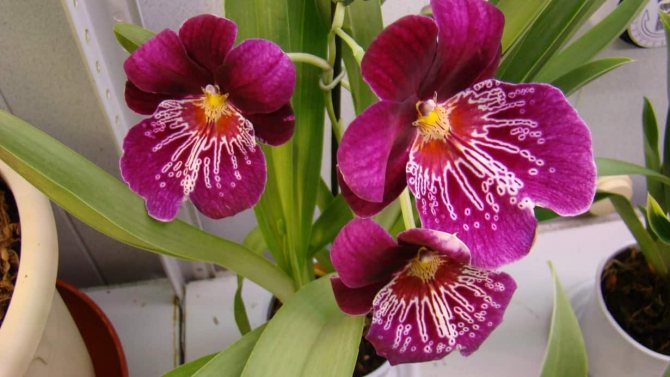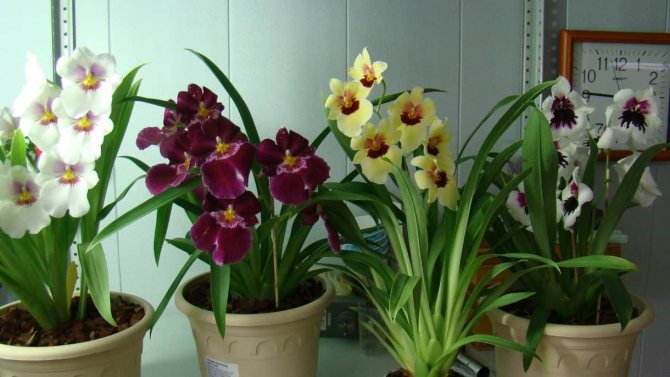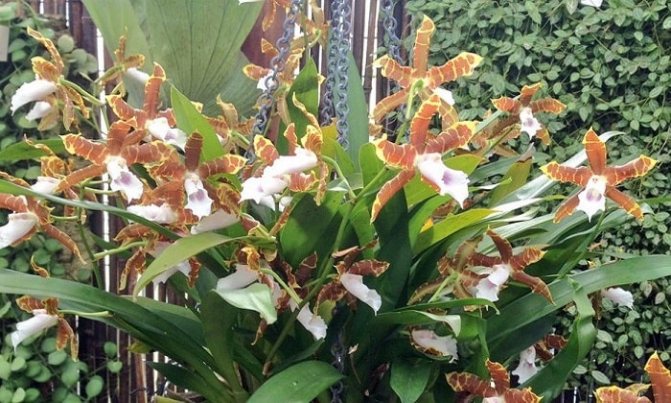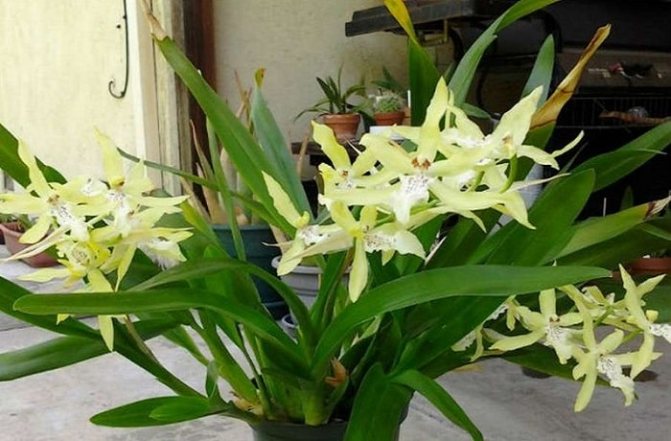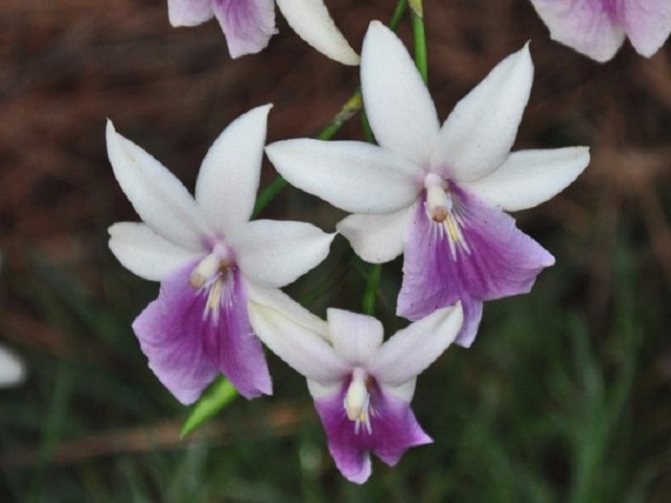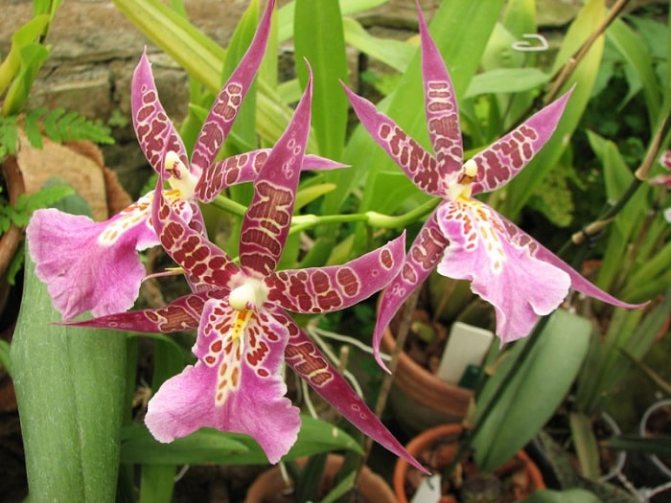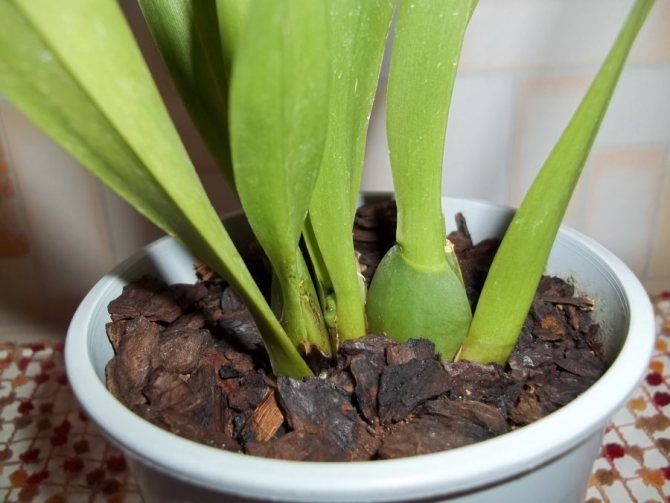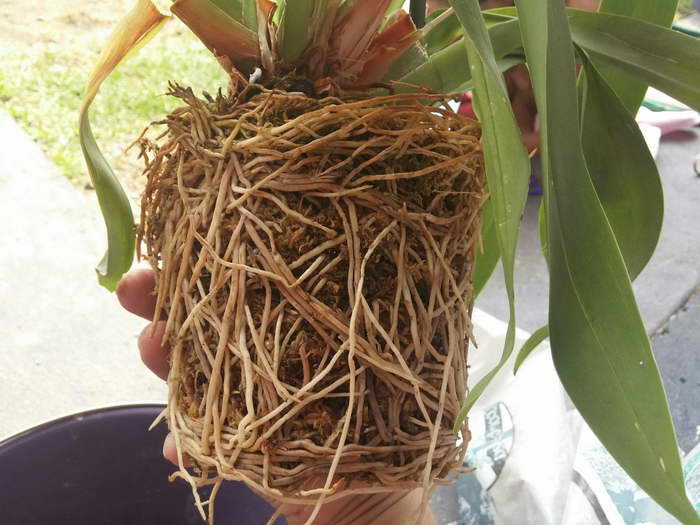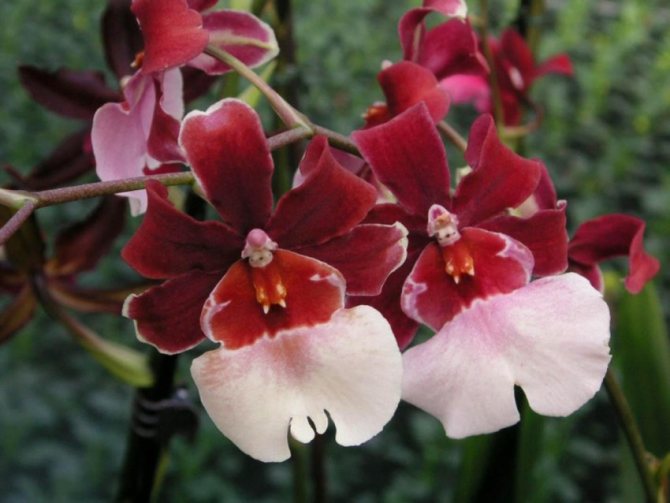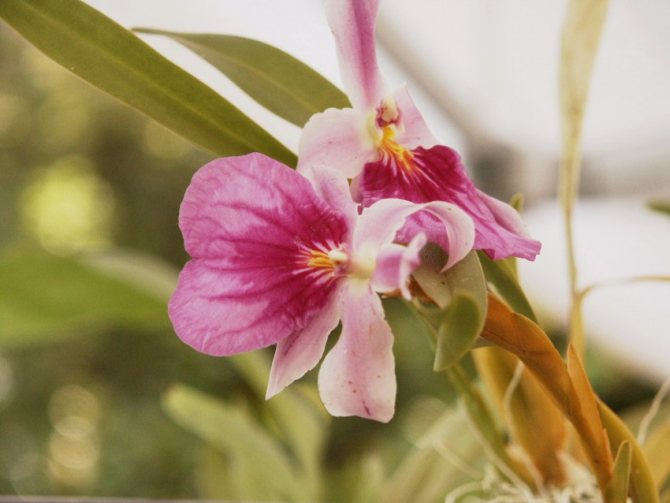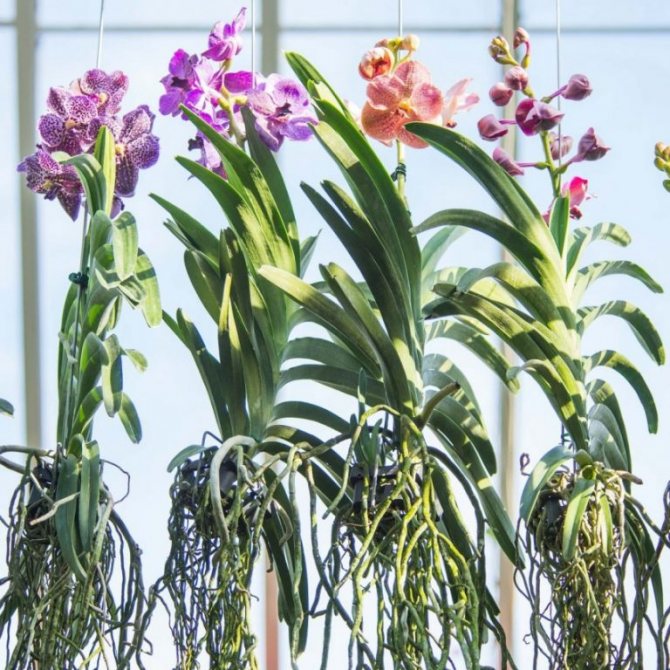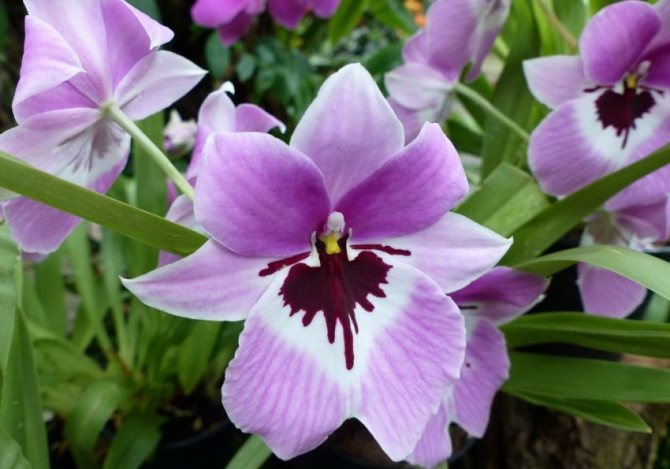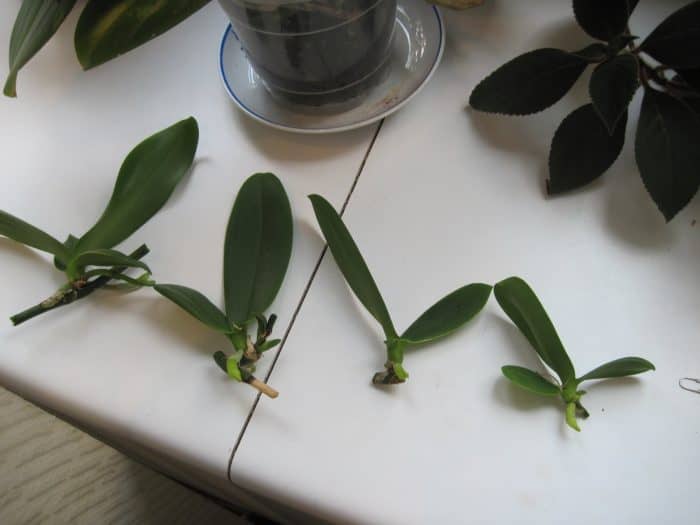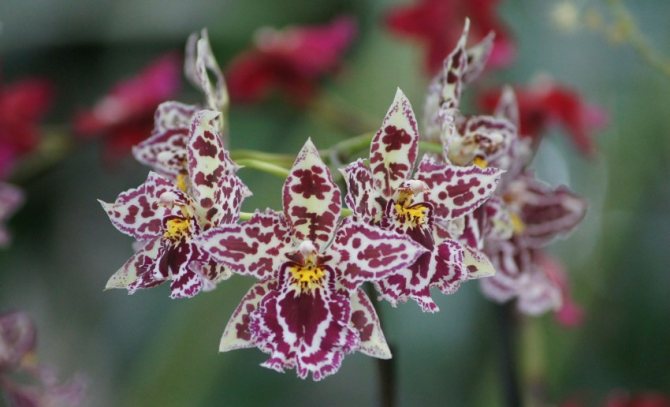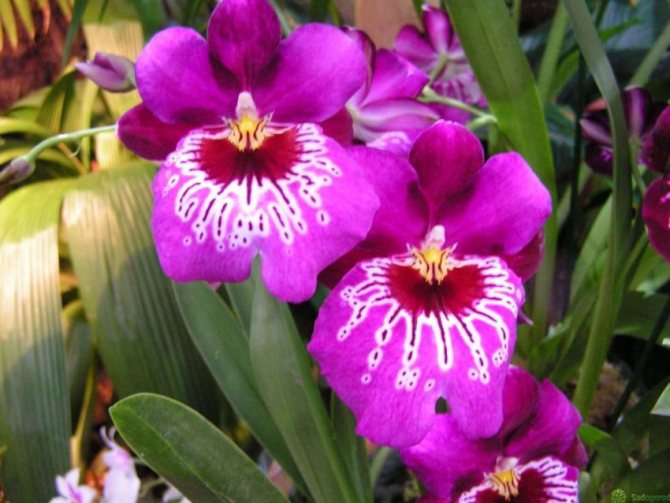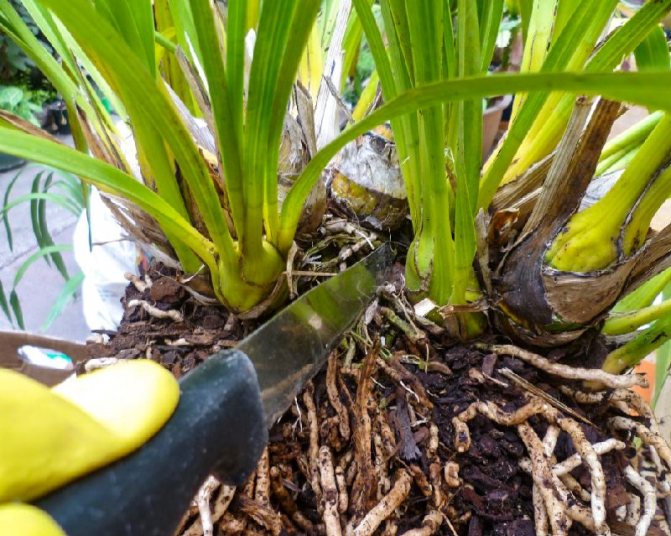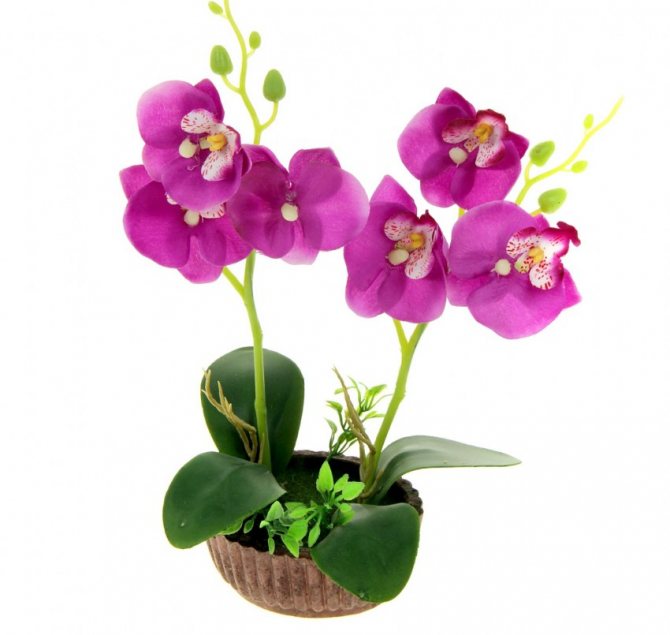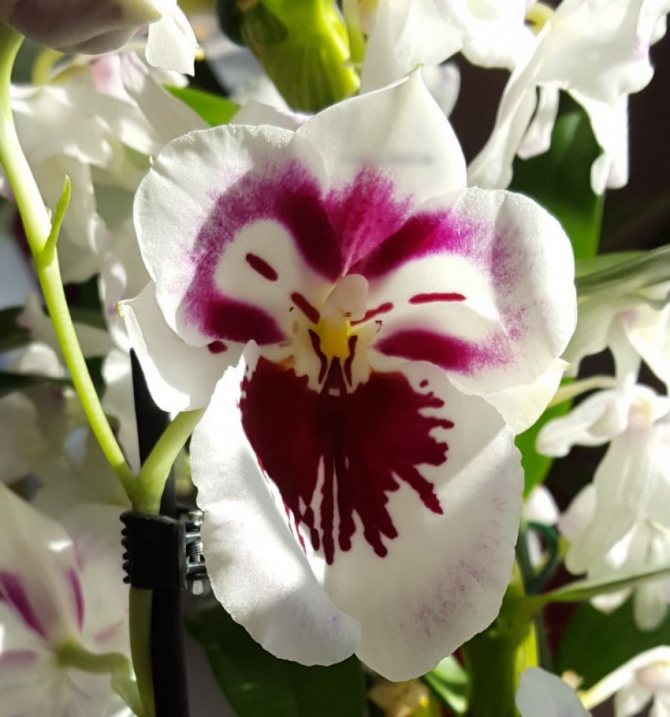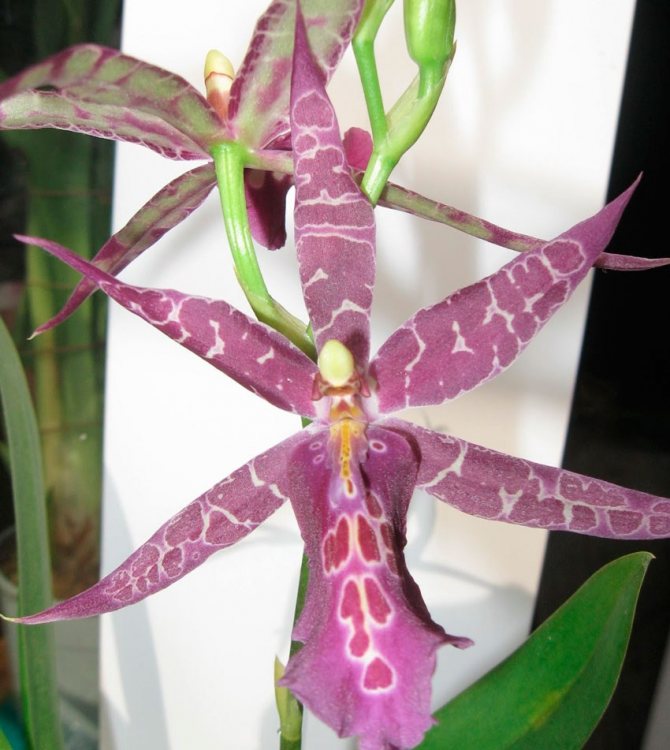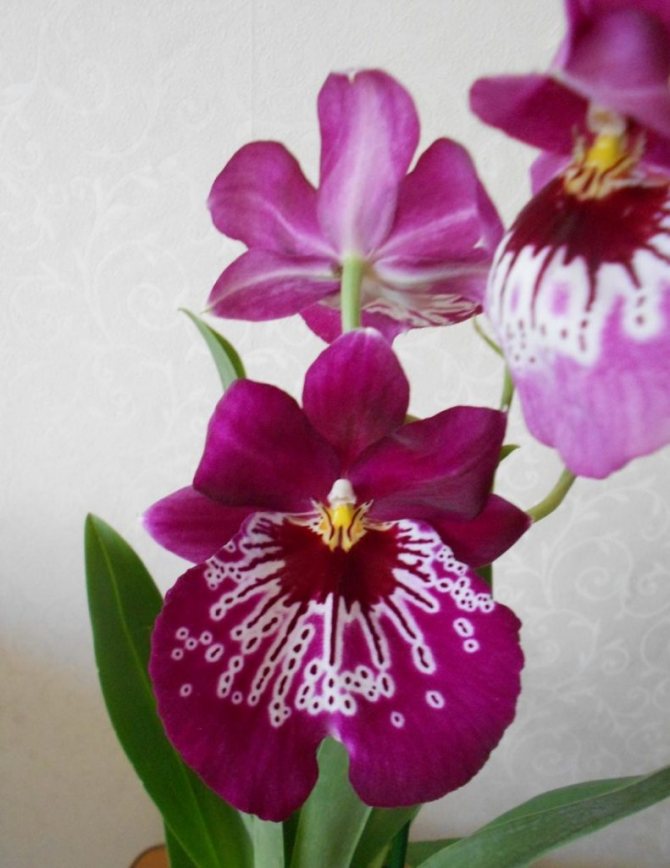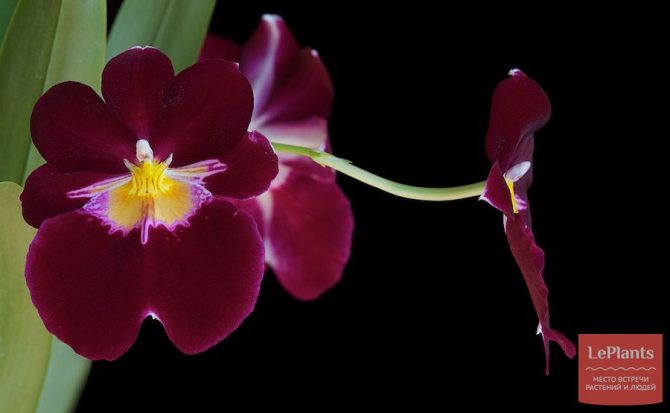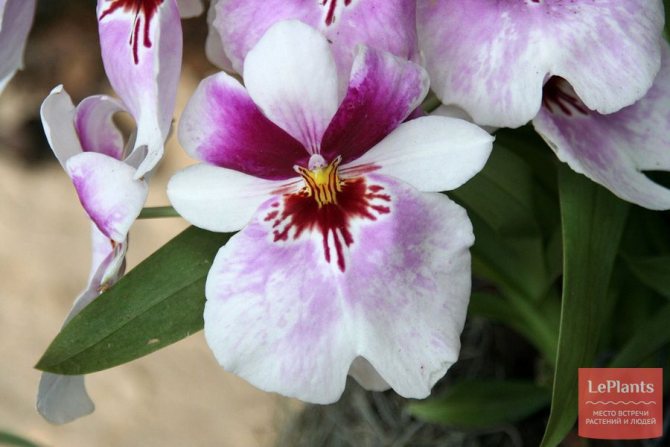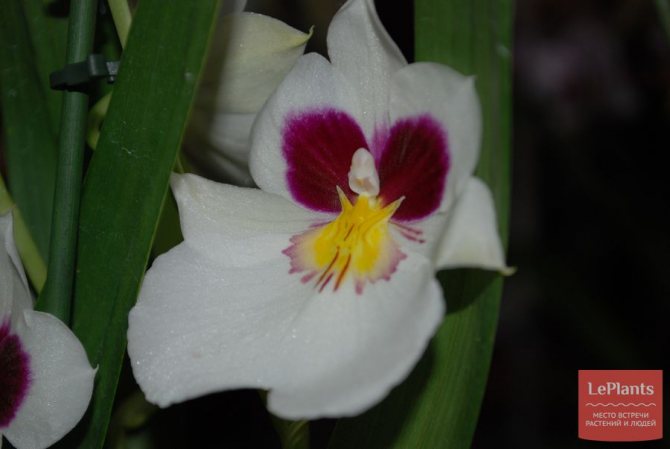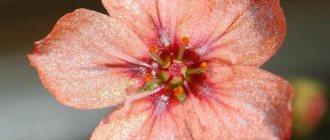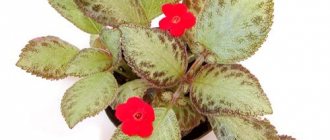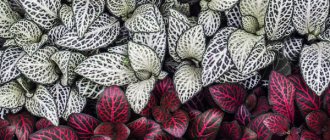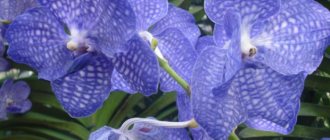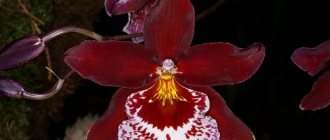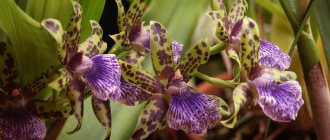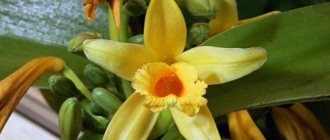Orchid Miltonia is native to warm South American countries with a humid climate, from the orchid family. Includes about 25 different types of orchids, is a perennial herb that lives in trees. Outwardly, they resemble the Pansy flower.
Many flower growers often have questions about the substrate, the choice of the pot, the watering regime, the illumination, the relative humidity, the temperature regime at which the plant is kept, the feeding and transplanting of the plant, as well as about reproduction. The article explains how to properly care for Miltonia orchids.

Confusion in classification and distinctive features of the genus
Those who first saw miltoniopsis do not immediately understand its "pedigree". A whole bouquet of flowers directed upwards suggests associations with simpletons pansies or field violets, but the unusual colors and sophisticated shapes make you think.
Miltoniopsis (lat. Miltoniopsis) belongs to the Orchid family, and the official name of the genus is translated into Russian as “similar to miltonia”. Initially (since 1837) they were one genus - Miltonia, in 1889 it was suggested that Brazilian orchids are very different. Since that time, 6 species began to make up a separate genus, although the justification of this isolation was scientifically proven only in 1976.
Short description
Plants of the genus are united by an epiphytic mode of life (attachment to tree trunks) and a sympodial type of growth (the presence of several growth points connected by special processes by rhizomes). Tuberidium (pseudobulb, false bulb, aerial or aerial tuber) is oblong in shape with a pair of belt-shaped leaves (miltonium pseudobulbs produce single leaf plates). False bulbs are located close to each other.
In nature, miltoniopsis settle on tree trunks in the rainforests of Colombia, Costa Rica, Panama, Peru, and Ecuador. They are found at an altitude of 213 to 2134 m above sea level.
In culture, they are not particularly whimsical, more resistant to cold and not so demanding on air humidity (in comparison with miltonia). Such an orchid is willingly grown at home, brought to work in offices and institutions in order to enjoy the beauty always and everywhere.
Is the beauty capricious?
The opinion about the capriciousness of miltoniopsis is unfair. The fact is that “purebred” species are demanding, but only hybrids and varieties are cultivated. In order for the leaves to retain a rich green color, and to bloom regularly, immediately after purchase it is necessary to choose a suitable place for the orchid (meaning light and temperature). You will need balanced watering, moderate humidity in the room, feeding, in the process of growing you will learn the basics of transplantation and reproduction. It does not have a rest period and develops under the same conditions throughout the year.
Flowering miltoniopsis


How miltoniopsis blooms at home
Peduncles appear only on mature mature pseudobulbs. The flowering period lasts 1 month and should be expected during April-July. Corollas about 12 cm in diameter have wide petals set apart and a large bilobate lip. The colors are made up of combinations of white, pink, yellow, lilac, purple shades.Distributed on the stem of 3-10 fragrant flowers.
Miltonia, popular with amateur flower growers
How many species of miltonia and miltoniopsis exist in nature, it is difficult to find out exactly. This is due to ongoing disputes over the classification and ease of formation of natural hybrids, including interspecies. Most often it is believed that there are about 20 "real" miltonias. At home, the most common are:
- Miltonia is snow-white. The height of the peduncles is up to 40 cm. Each has 3-5 flowers up to 10 cm in diameter. The petals are pastel yellow or brownish, with brick-colored spots. The plant owes its name to a snow-white lip.
- Miltonia is brilliant. Pseudobulbs are small (7–10 cm), flattened. Each has two sheets. The height of the peduncle is up to 30 cm. The petals are bright purple, the lip is pale purple with darker stains. Flowering lasts up to one and a half months.
- Miltonia Varshevich. Differs in large inflorescences. Rippled petals. If you do not cut the flower stalks, limiting yourself to removing wilted buds, you can achieve almost continuous flowering.
- Miltonia Renelli (sometimes not quite correctly called Miltonia Regnelli). Shiny leaves. Each peduncle has 3–7 flowers with a pronounced pleasant aroma. The petals are snow-white, the lip shimmers in different shades of pink and lilac.
- Miltonia Close. Peduncle up to 45 cm high. Flowers in the inflorescence 7-10. The yellow petals are streaked with brownish strokes and irregular spots. The dark purple tone of the lip turns sharply into snow-white.
- Miltonia Lawless Falls. Breeding hybrid, characterized by long and abundant flowering, as well as comparative unpretentiousness. On the initially white petals, streams of pink and scarlet paint seem to flow down. It blooms 2-3 times a year under optimal conditions.
Photo gallery: home-grown species
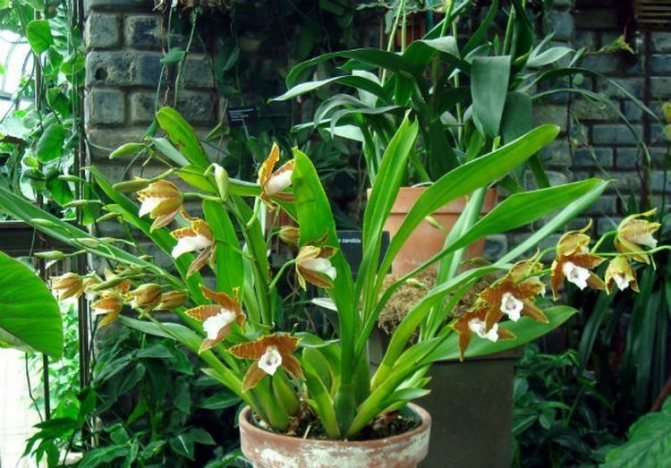

The name Miltonia snow-white owes to the lip of the corresponding shade, which stands out sharply against the background of dark brown petals
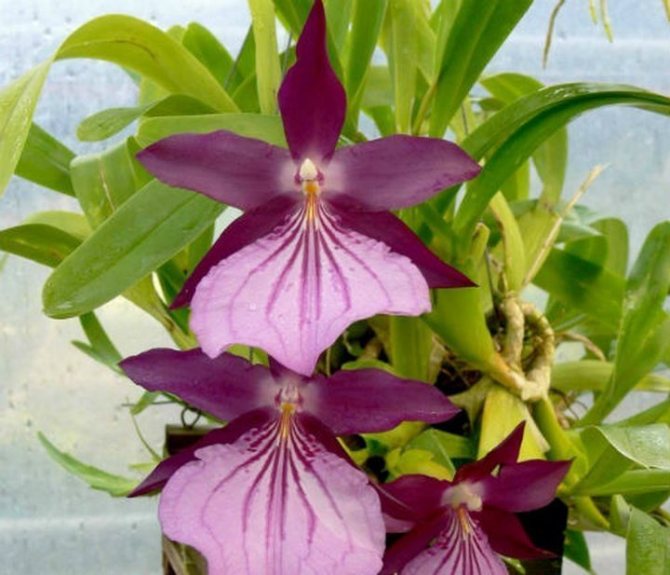

The heat-loving miltonia brilliant is capable of almost continuous flowering when properly cared for.
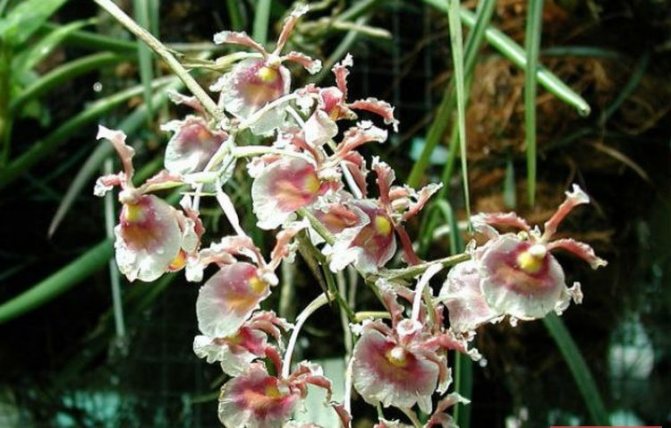

Miltonia Varshevich forms lateral peduncles, therefore it can bloom continuously for a year and a half.
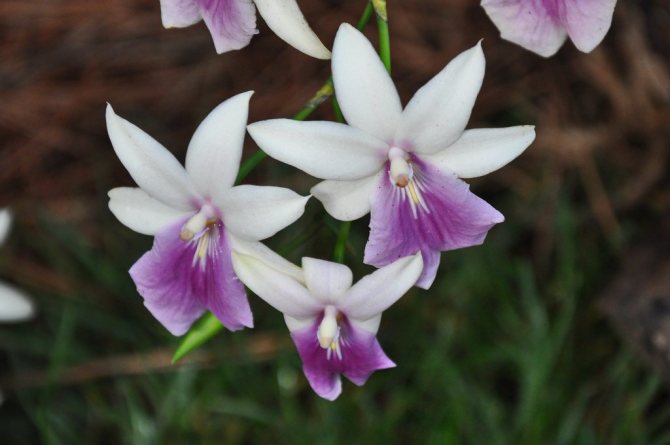

Peduncle of Miltonia Renelli holds up to 7 fragrant flowers for 1.5-2 months
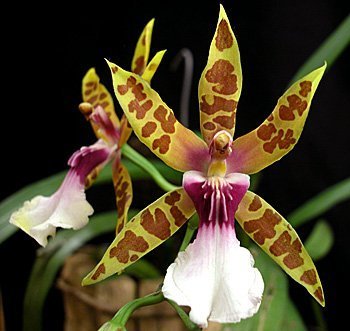

Miltonia Close looks like an exotic insect
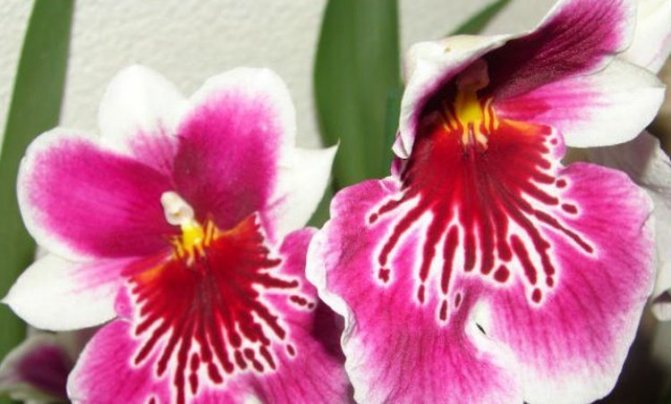

Hybrid Lawless Falls,
Orchid keeping conditions
Illumination
Intense lighting, especially direct sunlight, is harmful to miltoniopsis. It is not advisable to place it directly on the windowsill: such flowers are placed on whatnots or interior items not far from the east, west or south window. This quality allows miltoniopsis to be grown under fully artificial lighting. Only the shade of the leaves will become lighter, and the flowers will be somewhat smaller.
Air and ventilation temperature
The air temperature throughout the day can vary between 25-30 ° C. We replenish the intense heat by watering or increasing the level of humidity in the room. Cooling is necessary at night. For young orchids, indicators at this time of day should fluctuate between 18-20 ° C. Adult plants feel fine at the same temperatures or lower: 16-14, 14-12 ° C, and with dry soil - 10 ° C.
Even an adult developed miltoniopis bush may look exhausted by autumn. The seasonal drop in temperature helps to recuperate.
Pay attention to the need for regular ventilation. When the air is stuffy, the plant suffers, a favorable environment is created in the room for the development of fungal diseases. During the warm season, you can transfer your beauties to a balcony, loggia, veranda, terrace or garden. You just have to take care of the correct lighting, and light pots can also fall from strong gusts of wind.
Miltonia care by seasons
In spring and summer, keep the air temperature at 20 ° C, in winter - no more than 18 ° C. Comfortable maximum difference between day and night temperatures - 3-4 ° C. Otherwise, the number of shoots is reduced, they become smaller and grow extremely slowly. Frequent airing of the room is recommended to saturate the air with oxygen.
- A sharp change in temperature can negatively affect the condition of the plant.
- The unsuitable temperature regime will be indicated by the leaf plates of the plant, which will begin to shrink into an "accordion".
In winter, during dormancy, watering should be reduced as much as possible so that the plant is prepared for active flowering in the warm season.
How to care for miltoniopsis orchid at home
Watering
Miltoniopsis has thin roots and a thin protective velamin layer, so the systematic irrigation should not be underestimated. When the substrate reaches a slightly damp state, carry out the procedure again, in the summer this happens about 3 times a week. Both overdrying of the soil and waterlogging are harmful to the roots. In a relatively dry mode, the plant is kept during the growth of new roots.
Water miltoniopsis with warm purified water (filtered or settled tap water, you should not boil, you can use thawed or rainwater). Some orchids are watered by being completely submerged in water. Regarding miltoniopsis, the usual top watering is recommended: we move along the edge of the pot, without falling on the leaves.
Humidity of air and spraying
In the heat, we water the orchid more often and usually this moisture is sufficient, since it goes into the surrounding air. When the air in the room is dry, the balance should be replenished. The flower itself cannot be sprayed; irrigate the space in the room from a fine spray. Periodically, you can wipe the leaves with a damp sponge.
In winter, keep orchids away from heating systems. For humidification purposes, use special devices whenever possible. Placing an aquarium, a fountain or a small decorative element with water (a vase or, at worst, an ordinary jar) next to it looks beautiful and is useful at the same time.
Top dressing
Most experts recommend feeding the plant all year round. Every 2 weeks, apply fertilizer in a proportion of 30/10/10, and change every 3rd or 4th procedure to 6/30/30 (while diluting half a teaspoon in 3 liters of water). It is permissible to apply fertilizers every 7 days, reducing the concentration by half.
In flower shops, you can always find universal fertilizers for orchids; Pocon, Greenwold, Bona-forte, Kemira-lux are also suitable. Be precise with the dosage - pseudobulbs begin to die off in overfed plants. Spill the soil with clean water before fertilizing. Miltoniopsis cannot be fed on the eve of flowering and for 10-14 days after transplantation.
Choosing a substrate for an orchid
The substrate sold in stores is not entirely suitable, so it makes sense to tackle the question yourself - buy or collect pine bark in the forest, clean and boil it, add charcoal, peat, sphagnum moss, which is added in small quantities to the mixture and placed in the upper part soil. It is highly recommended to replace the moss every three months.
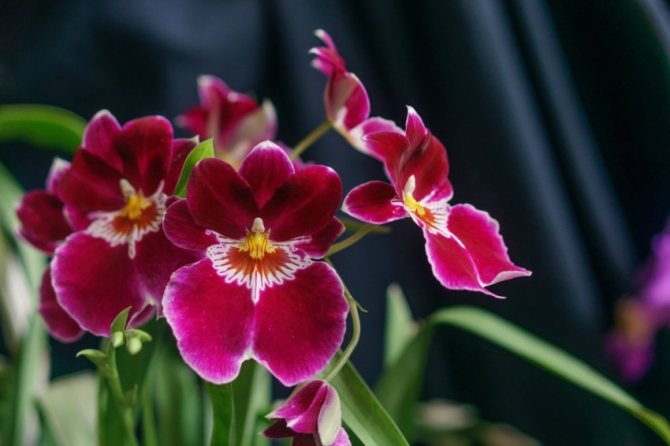

Orchid transplant miltoniopsis
It is recommended to transplant miltoniopsis immediately after purchase, but it is important to wait until flowering ends.
When grown in a plastic pot (we take it with a diameter of about 14 cm) with drainage holes at the bottom, an annual transplant will be required. In such a container, moisture stays longer, which is beneficial for the plant in hot periods of the year, but the roots may suffer from rot.
Like any epiphyte, miltoniopsis can be grown in wicker vines, wooden (about 2 cm wide) or plastic hanging baskets. The roots "breathe" better, but you will have to water more often and additionally worry about the humidity of the air.With this option, the transplant will be needed when the substrate is strongly overgrown or unusable (it is greasy, compressed, or, on the contrary, turned into dust).


- We carefully remove the flower from the previous pot.
- For a while, immerse the roots in water at a temperature of 35-38 ° C so that they are soaked and cleaned of the old substrate.
- Examine the root system for damage and decay. Cut off the affected areas with a scalpel or a sharp disinfected knife, treat the exposed tissue with a manganese solution, formic alcohol, or sprinkle with powdered charcoal.
- Cut dry leaves too.
- Embed the plant into the substrate to the same depth, pseudobulbs can stick out above the surface of the soil, but they cannot be pressed into the walls of the grate.
- For the first 3-4 days, do not water the flower and keep it in relative shade.
Flowering stems develop in the ground, so there is a risk of damage during spring transplantation. It is advisable to replace the soil in the fall.
The substrate needs to be drained, loose, permeable to water and air. The most suitable option is to buy special orchid soil. If you want to cook it yourself, you will need: some high-moor peat and deciduous humus, pieces of mahogany or spruce bark, about 10% charcoal. For an adult plant, a duet of perlite and medium fraction bark is suitable.
Pot selection
In the process of transplanting, a transparent plastic pot is selected, in order, firstly, to see the state of the root system, and secondly, the process of photosynthesis took place.


Each subsequent pot should exceed the previous one in diameter by 2 cm. Drainage holes are made in the lower part of the pot with a nail or screwdriver.


Reproduction of miltoniopsis orchid
It is almost impossible to grow miltoniopsis from seeds at home. The smallest seeds require special processing, and their germination occurs under constant light, temperature and humidity. A similar "climate" is available to breeders in nurseries.
In culture, miltoniopsis is propagated vegetatively ^
- Every 2-3 years, the bushes are allowed to be divided, combining the procedure with a transplant.
- Make a ditch of 3-5 pseudobulbs and immediately plant it in a substrate for an adult plant. Cut off the parts with a scalpel or a sharp disinfected (calcined, spilled with potassium permanganate) knife.
- Powder the places of the cuts with wood ash or an activated carbon tablet crushed into powder.
Air humidity
Recommended indicators of air humidity - 60-80%, provided that the room is well ventilated. A sign of a lack of moisture is the curling of the leaves of the plant.
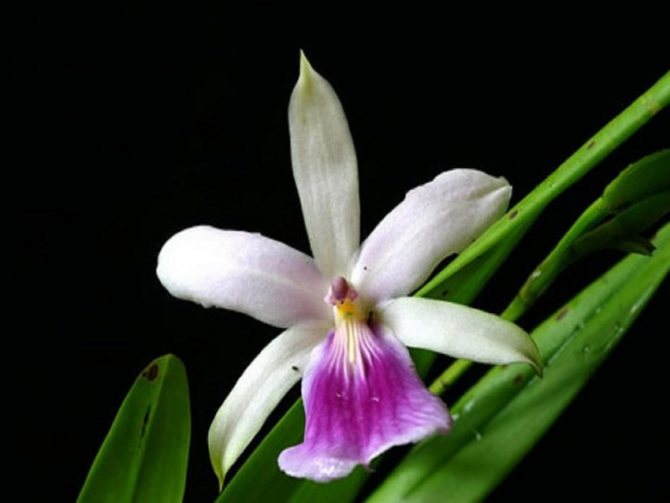

To provide the normal humidity for the orchid, the air around it is sprayed with water, but not sprayed on the plant itself. Or you can line the pot with wet expanded clay.
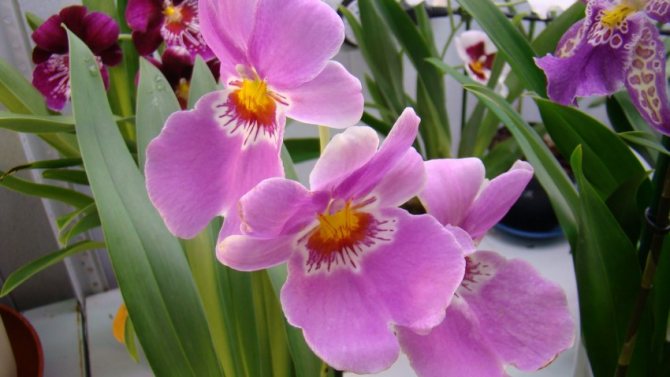

Diseases and pests
The sickly appearance of the plant is mainly due to improper watering. With insufficient soil moisture, the edges of the leaves dry out or they are completely collected with an accordion. Fungi develop from dampness, leading to rotting. Conduct an emergency transplant: cut off the affected areas with a sharp sterile object (scalpel or fire-calcined knife), treat the sections with a fungicide (Fundazol, Topaz, Vitaros, Ordan) and replace the substrate with a fresh one, disinfect the container.
Miltoniopsis can affect a pest such as a mealybug. It is an oblong worm with a cottony pubescence. Get rid of it with the help of insecticidal preparations such as Fitoverm, Actellik, etc.
Other difficulties in growing miltoniopsis:
- Leaves turn red from bright lighting;
- With a lack of light, the leaves darken;
- Miltoniopsis leaves turn yellow from waterlogged soil or lack of nutrients;
- The leaves wrinkle when the earthen coma is waterlogged;
- From salting the soil (when watering with hard water or excessive fertilization), the leaves fall off. Transplant will help;
- Short flowering and small buds - the orchid does not have enough space to grow, it must be transplanted into a slightly larger container;
- The buds fall off when there is a lack of lighting or root rot.
Illumination
Orchids cannot tolerate direct sunlight and require diffused lighting for about 12 hours a day. It is recommended to keep the flowerpot in the northeast window in summer and in the south in winter. In the case of an excess of light, the orchid leaves begin to turn yellow, and with a lack of light, they turn dark green, and the flowering stops. Depending on the state of the foliage, the illumination level is adjusted.
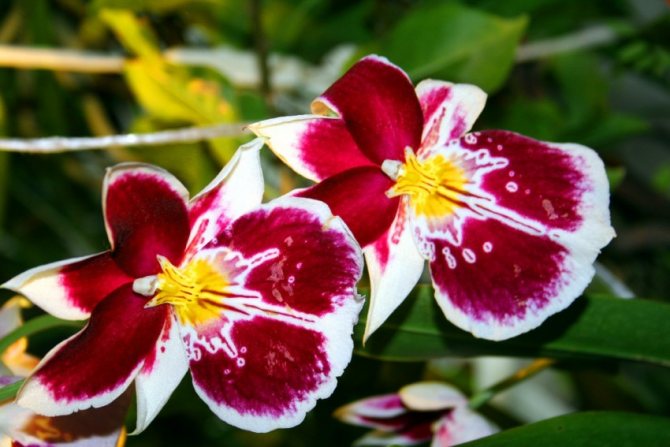

The best species and varieties of miltoniopsis
Miltoniopsis Phalaenopsis, Odontoglossum Phalaenopsis, Miltoniopsis Phalaenopsis, Odontoglossum Phalaenopsis
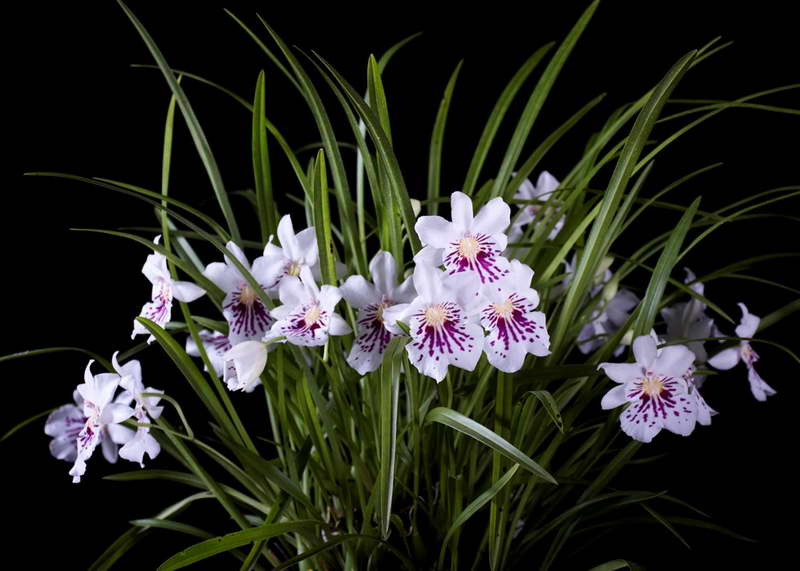

It is found in central Colombia and near Ocaña, in tropical forests near Veles at an altitude of 1200-1500 meters above sea level. It is an epiphytic orchid with pale green ovoid pseudobulbs. The height is 15-30 cm. Closer to the upper part of the peduncle, 3-5 corollas with a diameter of 5 to 6.5 cm are located. Most of the flower is snow-white, only the lip is decorated with light purple splashes or spots. Blooms from March to November.
Miltoniopsis sailing Miltoniopsis Vexillaria, Odontoglossum Vexillarium


Miltoniopsis vexillaria var Leucoglossa
Originally from Ecuador and Colombia. The height of the flower is 40-60 cm. Small flowers with a diameter of 5-10 cm are collected in lush brushes. The flower is completely pale purple, a thin border along the edges is white, the lip is yellowish or chestnut. Careful care is justified by almost year-round flowering with a peak in May-June.
Miltoniopsis Santana Miltoniopsis Santanaei


An orchid with a height of 40-60 cm. At the same time, several peduncles with pairs of corollas appear and the bush is covered with flowers around the entire perimeter. They are snow-white with a yellow lip, at the base of which purple lines sometimes appear.
Miltoniopsis Isler's
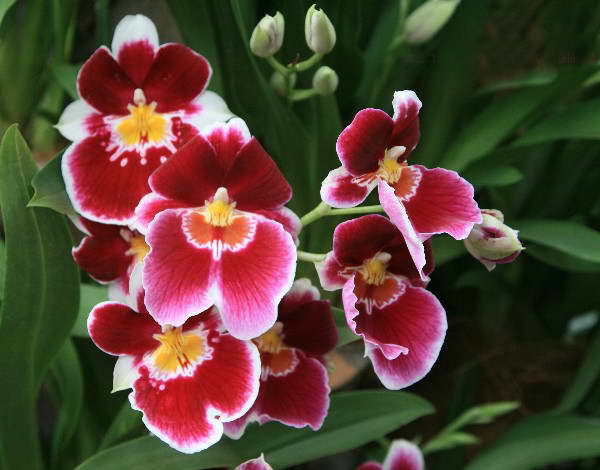

The hybrid is not whimsical at all and, in gratitude for the care, blooms magnificently. It is advisable to replant annually. The colors are white and burgundy. At the petals, a velvety-wine shade takes up most of the sepals, only strokes adorn the sepals, and the large lip is only bordered with white. The comb of a bright yellow hue takes on a bizarre shape.
Miltoniopsis Tania
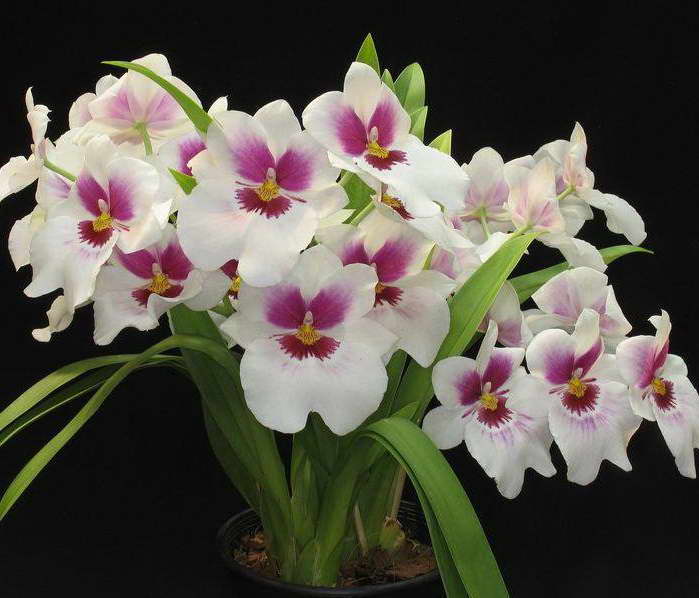

The flowering period of the hybrid lasts 1 month and should be expected in the summer. The lip is larger in relation to the rest of the corolla, its corrugation and deep purple color (there is a thin white border) create a mesmerizing sight. Sepals and petals are lighter.
Miltoniopsis Roezla, Miltoniopsis Roezl Miltoniopsis Roezlii, Odontoglossum Roezlii, Miltonia Roezlii
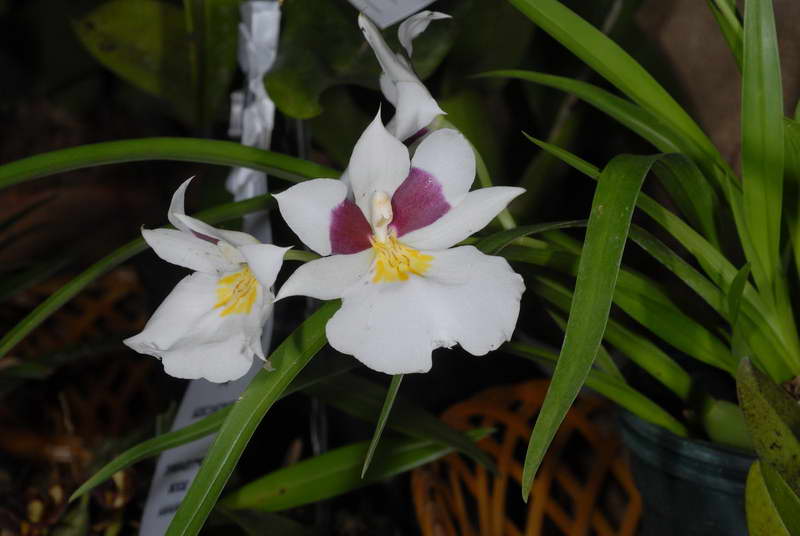

Originally from the warm humid forests of tropical Colombia, where it grows at an altitude of 300 to 1000 m above sea level. In growth, it does not exceed 40 cm. The oval-shaped pseudobulbs are slightly flattened, the surface is scaly, gray-green in color. The leaves have a bluish tint. Matured shoots give 1-2 peduncles with 2-5 corollas 7-10 cm in diameter. They are snow-white with large drops at the base of the petals. There are yellowish spots at the beginning of the lip. It usually blooms in the spring, and with good care, it re-throws out the peduncles in the fall.
Miltoniopsis Bismarckii
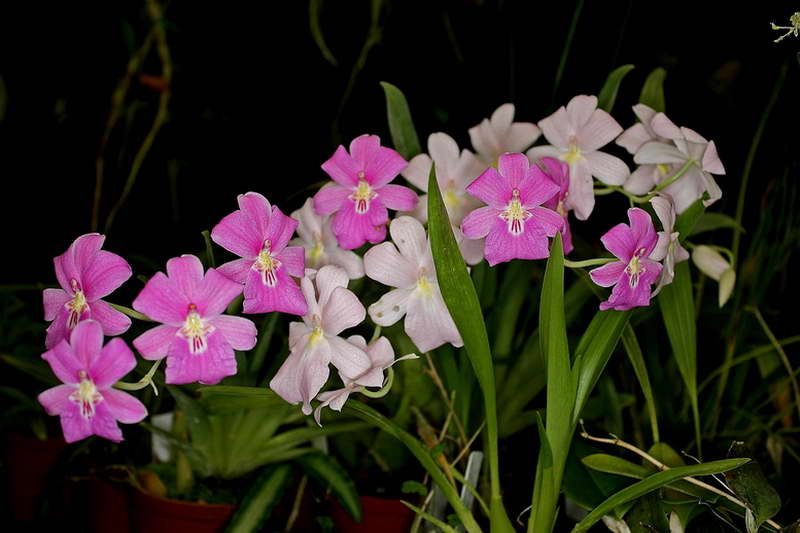

The orchid, about 20 cm in size, was discovered in 1985 and immediately fell in love with flower growers. Endemic to Peru. The pseudobulb is ovoid, flattened on the sides. Color in October-November. The inflorescence consists of 4-6 corollas with a diameter of about 4 cm. The shade is completely light lilac with a pearlescent sheen. Lip with a yellow disc.
Miltonia in natural conditions
In nature, miltonia prefers the shady, humid forests of Brazil, Paraguay, Argentina. Lives in trees, grows horizontally, forming thickenings at the base of the shoots, called pseudobulbs, accumulating nutrients and moisture.
Oval bulbs release leaves, peduncles, aerial roots, with the help of which Miltonia parasitizes on trees. Leaves, 35-40 cm long, with a special grayish-yellowish tone.Velvety flowers with a diameter of 10-12 cm open on the peduncles. The color is very diverse - white, red, yellow, pink, purple.
Description
The separation of Miltoniopsis into a separate genus of the Orchid family took place in the second half of the 20th century. Until then, he was united with the Miltonia clan. The disengagement only happened when scientific evidence joined the visible differences. Molecular studies have confirmed Miltoniopsis's right to "independence." The genus includes only 6 pure species, but the number of natural and artificial hybrids is in the tens.
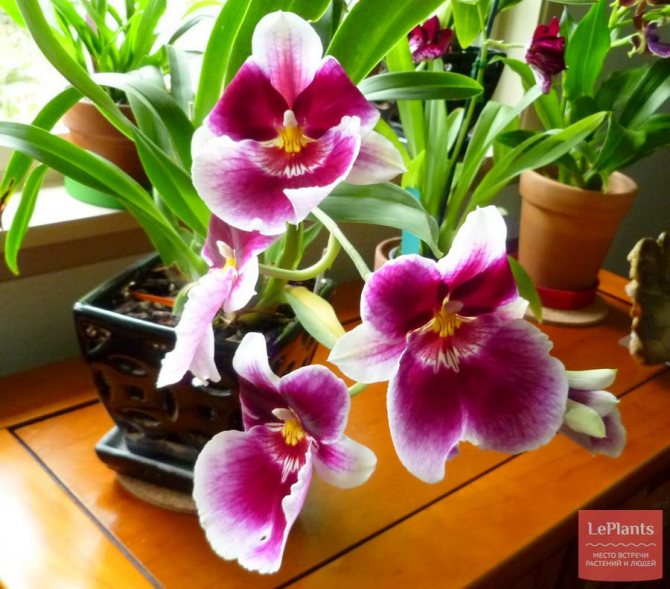

The pseudobulbs of the plant are small and strong. They simply "stick" to each other, leaving no free space. The color of glossy leaves is light green, the shape is lanceolate.
Unlike two-leaved Miltonia, Miltoniopsis has only one leaf blade.
Long stalks hold 2 to 7 flowers. Plants are especially beautiful in which the flowers are located one above the other. Each growth is marked by the appearance of 2-3 new peduncles. Proper care will guarantee multiple blooms throughout the year. Another difference between similar genera is the size of the lip. If in Miltonia it is small, then in Miltoniopsis it is much larger in size than the other components of the flower.
On the plant, fragrant flowers live from 1.5 to 2 months, but when cut, they fade right before our eyes.
Caring for "purebred" species is quite difficult, so less pampered hybrids are more popular with flower growers. The efforts of breeders are aimed at both reducing the size of the plant and creating original color solutions.
Problems that a novice florist may face
The problems of a plant can be judged by a change in its appearance. If nothing is done, the orchid can quickly die. Therefore, you need to be able to interpret the "signals" given by the flower and know how to react to them.
Table: how errors appear in the care of miltonia (leaves dry or turn yellow, buds fall) and how to save a plant
| Problem | Cause | What should I do? |
| Leaves darken. | Lack of light. | Use special phytolamps for additional lighting, if it is not possible to move the pot. |
| The leaves turn reddish. | The lighting is too bright. | Shade the orchid with a tulle curtain, gauze, thick paper. |
| Gray spots appeared on the leaves | Burn from direct sunlight. | |
| The leaves dry out in the form of an accordion, the shoots become "rickety", their number decreases. | Too low temperature of the content. | Move the flower to a warmer place. |
| Leaves turn yellow and dry. | Heat and stuffiness in the room. | Place the plant in a dark, cool place for several days. |
| The leaves at the base become corrugated, the growth of the orchid is greatly slowed down. | Irregular watering and fertilization or insufficient nutrient content of the substrate (a lot of time has passed since the last transplant). | Transplant the orchid immediately, completely changing the substrate. |
| The tips of the leaves dry out. | Watering with hard water (as a result, soil salinity). | Use only soft water for irrigation - rain or melted water. The water supply must be passed through a filter, defended, boiled. |
| Roots rot. | Frequent and / or excessive watering. | Transplant miltonia into a disinfected substrate. Water very carefully for the next 1.5–2 months. |
| The orchid stops growing, flowers and buds fall off. | Low humidity in the room (as a result - drying out of the soil). | Increase humidity in all available ways, increase the frequency of watering. |
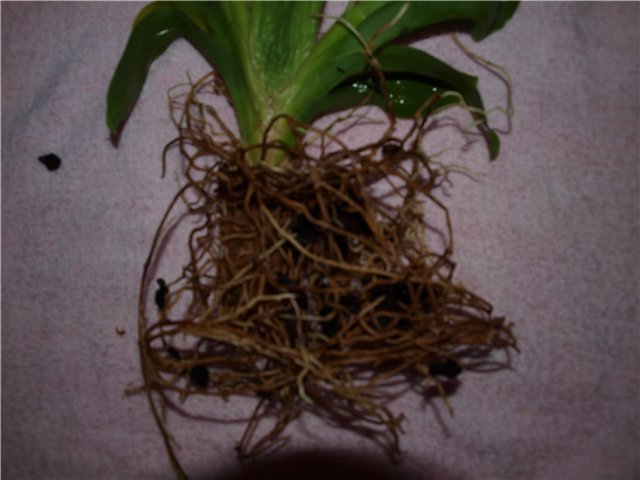

Decaying roots and wrinkled leaves of miltonia are symptoms that, upon seeing which the grower must immediately begin to take action, otherwise he will soon lose the plant
Growing
To avoid drying out and waterlogging of the Miltoniopsis roots, a well-drained, not quickly drying soil is needed. For example, you can add 10% charcoal to the bark of spruce and mahogany. Good results are obtained by a mix of coniferous bark (fine fraction) and perlite (10–20%). For adult plants, it is recommended to take the bark of the middle fraction.
Miltoniopsis should be transplanted annually, preferably during the cold season. At the same time, the use of a larger container is not as important as replacing the soil. Transplanting in autumn allows the plant to fully recover by spring. In fresh soil, the roots will develop well.
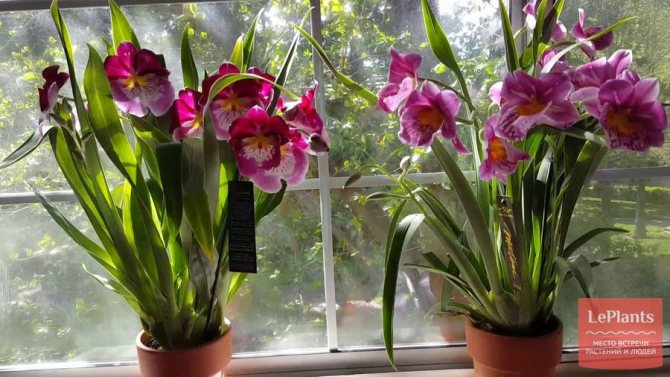

ON THE PICTURE: The choice of a pot should be given special attention. These orchids thrive best in 10-13 cm containers. In pots of this volume, the risk of waterlogging is reduced.
When reproduction by division it is necessary to provide each new plant with 3 to 5 pseudobulbs. The larger the orchid, the easier it is to recover after the procedure, the delenki acquire good immunity and begin to bloom earlier.
Dormant period
For full and long-term flowering, orchids need a dormant period. It lasts for 2-3 months. At this time, they need to lower the ambient temperature, reduce watering, and stop feeding. This is the most appropriate time for a transplant.
It's important to know. The peculiarity of Miltonia is that her peduncles are not cut off.
Due to the formation of lateral peduncles on them, this orchid is able to bloom all year round. Only flowers are removed from her. Leaves are cut off only if damaged by pests or diseases.
Diseases and pests
Miltoniopsis suffer from the same pests as the vast majority of orchids. Mostly from sucking parasites. Modern insecticides solve the problem.
Care must be taken when using preparations based on petroleum oils (emulsifiable concentrates). The delicate plant leaves are easy to burn. The procedure should be carried out in cloudy weather.
Fungal and bacterial rot rarely infect these orchids. As a rule, the cause of diseases lies in improper care: excessive watering, high humidity, excess fertilizers. The use of fungicides and bactericides in these cases is most often useless. If the affected area is high, then it is better to get rid of the plants so as not to jeopardize the rest of the collection. If the rot has not had time to spread, it is urgent to cut out the infected part with a sharp, sterile knife. Be sure to provide fresh air.
Recommendations for feeding
Fertilize Miltonia orchid using the immersion method. Once every 2-4 weeks, fertilizer for orchids is added to the water during watering. Another feeding method is spraying. The best method is to alternate root and foliar feeding.
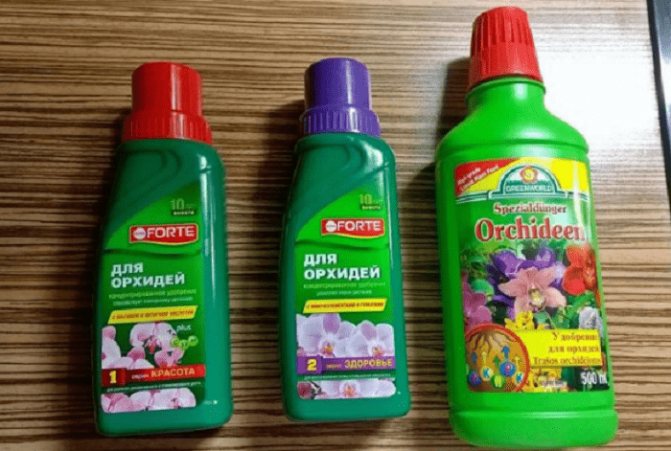

Experienced florists recommend halving the rate indicated on the label.
The frequency of fertilizing depends on the ambient temperature - they are carried out less often in a cool room. If the orchid is dormant, then it is not fertilized.
The period from April to September is the time of its growth, budding and flowering. At this time, she needs fertilizers.
First steps after purchase
Before purchasing Miltoniopsis, you need to make sure that there are no pests. The favorite habitat of insects is the seamy side of the leaves. During transportation it is necessary to protect the plant from bad weather.
If a blooming orchid is being bought, the transplant will have to be postponed until the end of flowering. In other cases, moving to a new substrate and a container of a suitable volume is carried out immediately.
After transplanting, the plant is not watered for several days, but only sprayed with air and soil.
Pruning and shaping miltonia
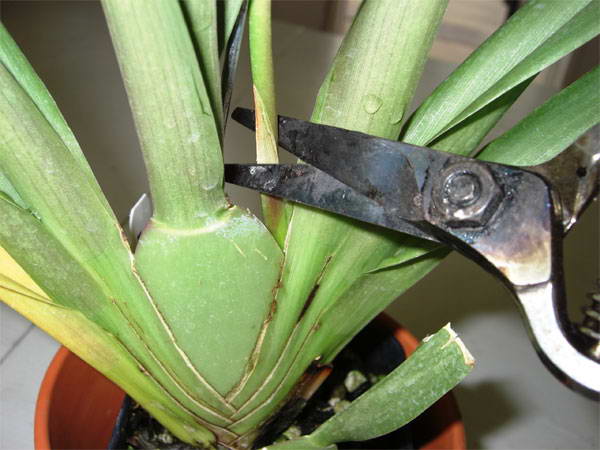

How to crop miltonia photos
After flowering, the peduncle is cut off, it will never again have flowers. As for the leaves, pruning the Miltonia orchid is necessary only if it is damaged by harmful insects or bacterial diseases. The flower does not need to form a crown.
Success secrets
Miltoniopsis have a reputation for being difficult to grow orchids. But although these plants are really not the easiest to care for, all difficulties are quite surmountable. Most species bloom regularly indoors.
For growth and flowering Miltoniopsis need good lighting... These orchids cannot grow in the shade of their neighbors. They need brighter lighting than green-leafed Paphiopedilums, comparable to that of variegated Venus shoes. At the same time, it should be lower than when growing Cattleya. Plant requests will be satisfied 9,000-10,000 lux... As a rule, these orchids have light green foliage, so some pallor of the leaf blades should not disturb the owners.
Sometimes Miltoniopsis are ranked as cold-kept orchids, such as their close relative, Oncidium Alexandra (Odontoglossum curly). These plants cannot stand the warmth, beloved by the Cattleyas or Vandas. But they also do not require cold snaps so valued by "odonts".
The indicator of night temperatures is not decisive. Miltoniopsis grow well together with Pafiopedilums (at + 12–14 ° C) and Phalaenopsis (+ 18–20 ° C). It is not recommended to exceed these values. In dry soil (but not with overdried roots) Maltoniopsis put up with a temperature of + 10 ° C. Young plants prefer relatively high night temperatures, adults are suitable for + 14-16 ° C.
Testimonials
Svetlana: “The glory of the capricious orchid, in my opinion, went to Miltoniopsis undeservedly. The trouble with him is no more than with his other relatives, say, with the well-known Phalaenopsis. It is almost impossible to find “purebred” species on sale, and all popular hybrids are perfectly adapted to indoor conditions. Miltoniopsis flowers are incredibly beautiful and smell like expensive French perfume. I advise all orchid lovers who have at least some experience in caring for orchids, feel free to purchase Miltoniopsis in their collection. "
Common colors
The market can do anything. Remember the phrase "There would be money!". Or "Any whim for your money!" Starting to list colors? Or won't we? Let us leave it to you to do it yourself.
And more about the colors. These are just some of the representatives. There are combinations that delight even connoisseurs and experienced florists... But the blue flowers did not have to be noticed. Maybe they are not in nature.
But Phalaenopsis are already growing and are sold in Royal Blue. At least in a year he will be with white flowers.
Fertilizer for miltassia
Like any plant, miltassia needs nutrients. For these purposes, any complex fertilizer or a specially formulated mixture for orchids can serve. In any case, it is necessary to make top dressing in a form diluted in water, otherwise the plant can get severe burns and die.
Therefore, it is better to dilute the dose recommended in the instructions with water twice. Fertilizers are applied either to the substrate when watering, or by spraying the leaves. It is necessary to apply both types of feeding alternately once every two weeks.
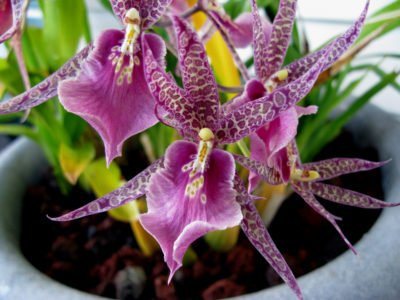

Soil for miltassia
The soil for the plant is prepared from peat, crushed pine bark and dried fern roots in a 1: 2: 1 ratio. The bark and parts of other plants in the composition of the substrate are vital for orchids, because they naturally grow on other plants.
However, they are not parasites, but extract nutrients from moisture and process them under the influence of sunlight through photosynthesis. At the bottom of the pot, drainage from pebbles must be laid, since.excess moisture can destroy the orchid's root system.


Monica
Under the name chaida monica hides a very ordinary, but varietal phalaenopsis with a spectacular color of flowers. You can see a photo of Monica's orchid below. This is a monopodial epiphyte:
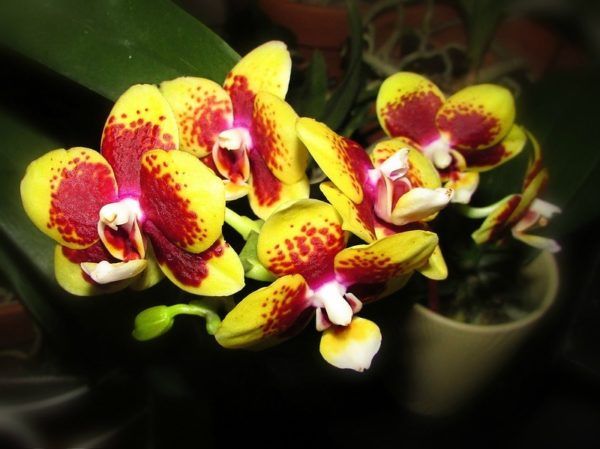

Chaida Monica Orchid is an incredibly bright and cute flower.
- Medium size;
- With wide and thick green fleshy leaves;
- Length 20-30 cm.
A plant with a peduncle in height can reach 60-70 cm... Abundant flowering, flowers:
- Large;
- 6-8 cm in diameter;
- Textured;
- Yellow with burgundy spots;
- The column is white.
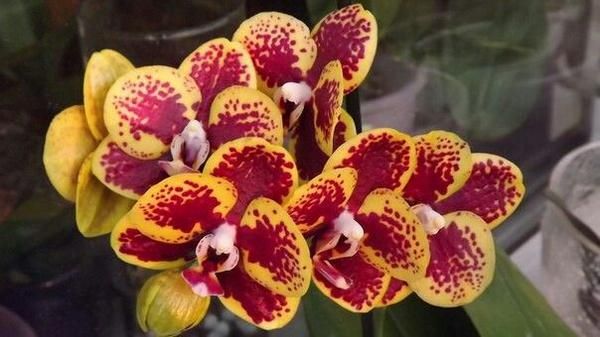

Chaida monica.
The orchid is looked after as a regular phalaenopsis. Blooms in winter, flowering duration 4-6 weeks, depending on the temperature of the content.
Planting and transplanting
Priming
- Pick up the soil. What can it be? It is up to you to determine. We have mentioned some options;
- If you cook yourself, remember ratio of components... And good preparation of the components (digestion, drying, grinding);
- And you can also find such a composition. The bark of coniferous trees. Peat and fern roots.
Capacity
As one gardener I know rightly says: “Don't stew in your own juice. You are not on a desert island! " Chat with amateurs and connoisseurs.
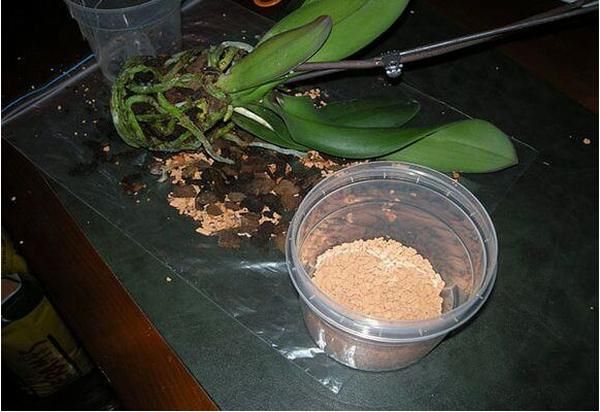

Especially with those who have experience in growing such plants. Including negative. And they will prompt:
- Large pot sizes are not suitable. The roots are not that big. It is not necessary to provide for growth;
- Will fit very well transparent plastic;
- Choose a container with good drainage holes at the bottom. To ensure unimpeded water flow;
- Nice pot is good. And better - suitable for the plant.
Features of the
- Pick up and prepare a container and soil;
- To remove old soil, first place in a container with warm water;
Important! Experienced flower growers leave part of the old soil when transplanting. The roots are used to it. If it is of high quality, then the plant tolerates this process more easily.
- Remove damaged and dried roots;
- Treat the sections with activated carbon;
- Let the roots dry;
- Lay the drainage;
- Place the plant;
- Fill carefully with soil. The soil covers only the roots;
- There is no need to water the first two days.
Transfer. Technology. Nuances
Miltonia Orchid confirms the reputation of being capricious and when transferring. Well, she doesn't really like this process. So spend it carefully. In compliance with rules and recommendations:
- Plants purchased from stores must be transplanted. If it blooms, give it the opportunity to bloom;
- Repot your orchid no more than 2 years later. 3-4 years as an ideal;
- But the circumstances must also be taken into account. Maybe more often: What is the condition of the soil;
- How plants feel;
- Possible diseases and emerging pests themselves speak of the need to change the soil;
How to transplant:
- Inspect carefully roots and leaves: Remove dried leaves;
- Assess the condition of the big ones. Maybe they have already served their time. For more free growth of fresh leaves;
- It can be polystyrene, expanded clay;
The main enemies of Miltonia
Orchids attack thrips, scale insects, whiteflies, spider mites, mealybugs. Let's briefly dwell on each of them:
- The increased temperature of the ambient atmosphere and insufficient humidity often lead to the multiplication of thrips. They look like gray dots on the leaves, which become silvery.
- Visible brown plaques on the leaves indicate scaly colonization.
- When a plant is affected by a whitefly, yellow and whitish spots are visible at the bottom of the leaves, which gradually discolor, turn brown and die.
- Too high temperature and dry air cause the appearance of another pest - spider mites.
- The mealybug attacks the roots of the plant, causing the orchid tissue to dry out.
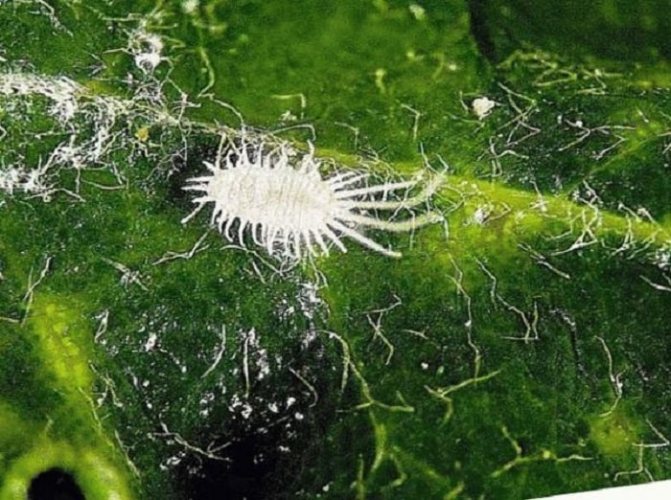

Mealybug
Control measures are reduced to processing Miltonia with soap solutions (removing insects from leaves by mechanical means) and spraying with insecticides, such as fitoverm, actellik.
The main features of a correct fit
Usually they use store substrates for orchids based on pine or pine. A “home” substrate made of prepared pine bark, expanded clay and coal in a ratio of 3: 1: 1 is also perfect.
Orchid planting containers are absolutely indifferent. Perfect fit ordinary plastic pots or special baskets. Orchids attached to a block look very impressive. It is important that there are drainage holes in the pot.
The technology of planting orchids is fundamentally no different from planting other indoor plants. Neatness is key work with a fragile root system most orchids, especially epiphytes.
Orchids are transplanted as rarely as possible, then when the plant has already outgrown the pot or the old substrate has decomposed and fell into disrepair.
Important! Orchid transplantation is carried out after flowering, except in cases where it is urgent to save the plant.
3. Varieties:
3.1 Miltonia Honolulu
Compact epiphytic orchid with long, green, glossy, linear leaves up to 25 cm long. The peduncle is strong, upright, up to 15 cm high.Each flower stem can contain 2 - 3 flowers up to 8 cm in diameter. With petals painted in purple, lilac or dark pink shades. The lip is wide, with wavy edges. Petals are oblong, often pointed. The flowering period lasts from one and a half to three months.
↑ Up,
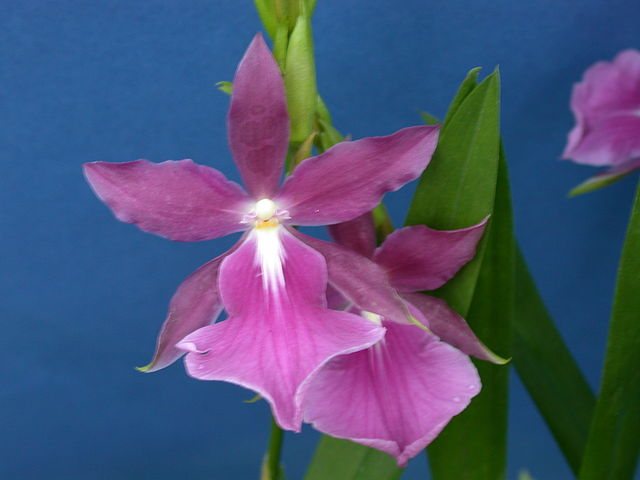

Confusion with names
Despite the fact that on sale you can often find orchids with the name "miltonia", in fact, it is extremely rare to find it in its pure natural form, even on specialized counters. Usually, this name refers to garden hybrids, of which there are many in culture. Everything is explained simply. The plant business, including the sale of orchids, should be profitable, which is why unpredictable specimens do not hit the shelves of ordinary stores. But here you can find in abundance unpretentious varieties and hybrids that have successfully inherited the decorative and vitality of the basic forms.
In addition, even experienced orchid growers argue over the botanical classification of this genus. The reason for this is the existence of two closely related genera: Miltonia and Miltoniopsis, which until recently were listed under the single genus Miltonia.
In nature
- Perennial herb. Epiphytic... They grow on trees. But they don't get food from them. A tree with their branches with trunks as a support, a frame. Environment - power source;
- Connoisseurs-florists about Miltoniopsis: Some believe that this orchid is the least problematic among other orchids. To grow in an apartment;
- There are also opposite views. The most capricious!
- Even Wikipedia notes that the systematic position of the genus is not well-established;
- In the mountains, where they grow more naturally, it is not so hot - 23-25 degrees. Humidity is quite high - 60-80%. A lot of lighting suits them.But they hide from the sun;
- They are thermophilic. This is the climate of the state of Espiritu Santo. In the southeast of Rio de Janeiro. Brazil;
- Charles and Margaret Baker tried to answer many questions;
General information
Miltassia, like other orchids, is grown for its outlandish, original and beautiful flowers. And how disappointed growers are if they do not get abundant and long-awaited flowering! But, in most cases, they themselves are to blame for this - they could not arrange elementary living and care conditions for the plant.
First of all, the miltassia orchid needs periodic rest, which consists in lowering the temperature and stopping abundant watering. The temperature regime when growing a plant is also important here - at night the temperature should drop by at least 4 degrees.
If the flowers still appear, then they must be cut off, thereby achieving the release of new peduncles. It is difficult to maintain such a regime in an apartment, but you need to try by varying the humidity, which can be raised by a vessel with water or wet expanded clay located next to the flower.


Care
Substrate
The choice of soil for an orchid is taken seriously, as it reacts sensitively to soil that does not meet the requirements, loves moist, ventilated soil. To get it, mix pine bark (peeled and boiled), peat, perlite, charcoal, sphagnum moss. It is added in a small amount and placed on top of the soil. It purifies the water intended for irrigation. Change every quarter.
Pot
The best option for planting at home is a transparent plastic container. The roots of a plant in the process of photosynthesis need light, and you can monitor their condition without any problems. When transplanting, the diameter of each next pot is increased by 3 cm, otherwise the development of the plant will stop. In order to prevent stagnation of water in the pot, if there are few drainage holes in it, holes are added around the circle with the help of improvised means. This will provide good ventilation of the land and high-quality irrigation.
Watering
An important procedure in the life of an orchid. During its implementation, some rules are observed. Miltonia prefers clean water. Suitable for this distilled or melted temperature from +30 to +45 degrees C. Irrigate sparingly, without flooding. This is the main trouble for miltonia. There is a fine line here, which should not be violated.
It is necessary to take into account the temperature regime of the room where the plant is contained and humidity, as well as the stage of its development (blooms, rests). Under normal conditions, irrigate once every 4 days.
During the period of intensive growth, water is plentifully, preventing drying out, and excess liquid is removed from the pan. This will help avoid the death of miltonia. In a dry substrate, the orchid will shed its buds, in a wet one, the bulbs will rot. Water at intervals of 5 days. In hot weather - more often, in winter - less often.
Better to use the "hot shower" method. This requires water with a temperature of +45 degrees C. This is useful for the plant, since conditions are created that are close to natural, natural. At the end of the procedure, we wait for all the liquid to drain into the pan, and then wipe the leaves dry.
You can briefly immerse the pot in a container of water. This helps the substrate to get wet gradually and evenly. It is helpful to spray the surface of the moss. It will take in water, which is enough to fully moisten the soil.
Pour the liquid out of the tray in time and dry the pot on the wire rack so that excess moisture does not linger.
Illumination
Miltonia is undemanding to a lot of light, does not like heat. In the summer, it is better to place it on the northeast window, in the winter - on the south. And to create a cool atmosphere, they are placed near the balcony door or on the loggia. The main condition is the absence of drafts.
Adequate amount of sunlight is determined by the color of the leaves. If they become yellow, then the plant is removed away from the light source. An orchid with dark green leaves is placed close to the window. With a lack of sunlight, miltonia "freezes" and stops blooming.
Temperature
The orchid feels comfortable in a cool room. A high degree of heating of the air in the house adversely affects the condition of the flower. In winter, it is maintained no higher than +10 - +18 degrees C, in summer - no more than +25. Therefore, the room is equipped with a thermometer. If it is warmer than needed, pieces of ice are placed in a pan around the pot.
Humidity
Its everyday level (50%) in the room is not enough. The optimal "fork" is from 60 to 80%. The air around the orchid is carefully sprayed, preventing moisture from entering the plant (dark spots will appear). A container with water, wet expanded clay is placed next to it. Miltonia is good in the kitchen, it's warm and humid. Thus, a climate is created that is close to natural.
In other conditions, the leaves are deformed and curled.
Top dressing
Fertilize miltonia every month. This is done after watering, using organomineral fertilizers marked "for orchids", which are in abundance at retail outlets. Before starting work, you need to carefully study the recommendations on the packaging, and then act according to the instructions. To make miltonia bloom profusely, top dressing is done regularly.
Dormant period
High-quality care is the key to an orchid blooming within two months. Then she needs rest. Then a new phase of bud formation will begin. This happens after each flowering and in winter. The size of the newly formed pseudobulbs is compared to last year's. This requires non-standard conditions. The obsolete peduncle is carefully cut at the root, trying not to harm the pseudobulbs. For a couple of months, the plant is determined in a bright room with an air temperature of +15 to +18 degrees C, reducing the frequency of watering (to 1 in 1.5-2 weeks). If necessary, arrange additional artificial lighting. Top dressing is not done. When new flower stalks appear, miltonia is returned to warmth and cared for in the same way.
In the absence of an acceptable room, with the necessary conditions, miltonia is moved closer to the window glass and fenced off from the warm room with an impromptu partition. Nearby radiators are covered with a thick cloth.
Transfer
After two years, the orchid changes the ground. They do it as follows. The flower is carefully removed from the pot. The roots are cleaned of old scales, inspected for insects and damage. Then the plant is placed in the Cornesil solution. After that, the scissors are disinfected with alcohol and the dead roots are removed. Pebbles are placed on the bottom of the pot, part of the prepared substrate, the plant is carefully and carefully placed, not forgetting to lay the roots along the inner edge, and the orchid itself in the center. Fall asleep with the remaining earth. Then the pot with miltonia is immersed in a container with liquid Zircon fertilizer for 5-10 minutes. This procedure will help the roots to cope with the shock. If water does not penetrate to them, then irrigate from above, not forgetting to cover the soil with sphagnum moss in advance.


